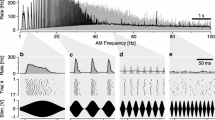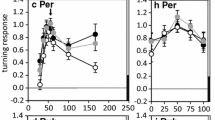Abstract
Since decades the acoustic communication behavior of crickets is in the focus of neurobiology aiming to analyze the neural basis of male singing and female phonotactic behavior. For temporal pattern recognition several different concepts have been proposed to elucidate the possible neural mechanisms underlying the tuning of phonotaxis in females. These concepts encompass either some form of a feature detecting mechanism using cross-correlation processing, temporal filter properties of brain neurons or an autocorrelation processing based on a delay-line and coincidence detection mechanism. Current data based on intracellular recordings of auditory brain neurons indicate a sequential processing by excitation and inhibition in a local auditory network within the protocerebrum. The response properties of the brain neurons point towards the concept of an autocorrelation-like mechanism underlying female pattern recognition in which delay-lines by long lasting inhibition may be involved.







Similar content being viewed by others
Abbreviations
- AN:
-
Ascending neuron
- AP:
-
Action potential
- BNC:
-
Brain neuron class
- B-LC:
-
Brain neuron, local, contralateral axon
- B-LI:
-
Brain neuron, local, ipsilateral axon
- CNS:
-
Central nervous system
- DN:
-
Descending neuron
- ON:
-
Omega neuron
- PSP:
-
Post synaptic potential
References
Alexander RD (1962) Evolutionary change in cricket acoustical communication. Evolution 16(4):443–467
Bentley D (1977) Control of cricket song patterns by descending interneurons. J Comp Physiol A 116(1):19–38
Bullock TH (1961) The problem of recognition in an analyzer made of neurons. In: Rosenblith WA (ed) Sensory communication. MIT Press, Massachusetts, pp 717–724
Buonomano DV (2000) Decoding temporal information: a model based on short-term synaptic plasticity. J Neurosci 20(3):1129–1141
Bush SL, Schul J (2006) Pulse-rate recognition in an insect: evidence of a role for oscillatory neurons. J Comp Physiol A 192(2):113–121
Carr CE, Konishi M (1988) Axonal delay lines for time measurement in the owl’s brainstem. Proc Nat Acad Sci 85(21):8311–8315
Clemens J, Hennig RM (2013) Computational principles underlying the recognition of acoustic signals in insects. J Comp Neurosci 35(1):75–85
Crawford JD (1997) Feature-detecting auditory neurons in the brain of a sound-producing fish. J Comp Physiol A 180(5):439–450
Cros E, Hedwig B (2014) Auditory pattern recognition and steering in the cricket Teleogryllus oceanicus. Physiol Entomol 39(1):19–27
Doherty JA (1985) Trade-off phenomena in calling song recognition and phonotaxis in the cricket, Gryllus bimaculatus (Orthoptera, Gryllidae). J Comp Physiol A 156(6):787–801
Edwards CJ, Leary CJ, Rose GJ (2007) Counting on inhibition and rate-dependent excitation in the auditory system. J Neurosci 27(49):13384–13392
Gerhardt HC, Huber F (2002) Acoustic communication in insect and anurans. University of Chicago Press, Illinois
Haskell P (1956) Hearing in certain Orthoptera I. Physiology of sound receptors. J Exp Biol 33(4):756–766
Hedwig B (2000) Control of cricket stridulation by a command neuron: efficacy depends on the behavioral state. J Neurophysiol 83(2):712
Hedwig B (2006) Pulses, patterns and paths: neurobiology of acoustic behavior in crickets. J Comp Physiol A 192(7):677–689
Hedwig B, Poulet JFA (2004) Complex auditory behavior emerges from simple reactive steering. Nature 430(7001):781–785
Hedwig B, Poulet JFA (2005) Mechanisms underlying phonotactic steering in the cricket Gryllus bimaculatus revealed with a fast trackball system. J Exp Biol 208(5):915–927
Hennig RM (2003) Acoustic feature extraction by cross-correlation in crickets? J Comp Physiol A 189(8):589–598
Hennig R, Otto D (1996) Distributed control of song pattern generation in crickets revealed by lesions to the thoracic ganglia. Zoology 99:268–276
Hoy R (1978) Acoustic communication in crickets: a model system for the study of feature detection. Fed Proc 37(10):2316–2323
Hoy RR, Hahn J, Paul CR (1977) Hybrid cricket auditory behavior: evidence for genetic coupling in animal communication. Science 195:82–84
Huber F (1962) Central nervous control of sound production in crickets and some speculations on its evolution. Evolution 16(4):429–442
Huber F, Moore TE, Loher W (1989) Cricket behavior and neurobiology. Cornell University Press, New York
Hutcheon B, Yarom Y (2000) Resonance, oscillation and the intrinsic frequency preferences of neurons. TINS 23(5):216–222
Konishi M (1991) Deciphering the brain’s codes. Neural Comput 3(1):1–18
Kostarakos K, Hedwig B (2012) Calling song recognition in female crickets: temporal tuning of Identified brain neurons matches behavior. J Neurosci 32(28):9601–9912
Large EW, Crawford JD (2002) Auditory temporal computation: interval selectivity based on post-inhibitory rebound. J Comput Neurosci 13(2):125–142
Moiseff A, Hoy R (1983) Sensitivity to ultrasound in an identified auditory interneuron in the cricket: a possible neural link to phonotactic behavior. J Comp Physiol A 152(2):155–167
Olshausen BA, Field DJ (2004) Sparse coding of sensory inputs. Curr Opin Neurobiol 14(4):481–487
Ostrowski T, Stumpner A (2013) Processing of ultrasound in a bush cricket’s brain. Physiol Entomol 38:33–34
Pollack GS, Hoy RR (1979) Temporal pattern as a cue for species-specific calling song recognition in crickets. Science 204:429–432
Poulet JFA, Hedwig B (2005) Auditory orientation in crickets: pattern recognition controls reactive steering. Proc Nat Acad Sci 102(43):15665–15669
Poulet JFA, Hedwig B (2006) The cellular basis of a corollary discharge. Science 311(5760):518–522
Priebe NJ, Ferster D (2012) Mechanisms of neuronal computation in mammalian visual cortex. Neuron 75(2):194–208
Regen J (1913) Über die Anlockung des Weibchens von Gryllus campestris L durch telephonisch übertragene Stridulationslaute des Männchens. Pflüg Arch Europ J Physiol 155(1):193–200
Reiss R (1964) A theory of resonant networks. In: Reiss R (ed) Neural theory and modeling. Stanford University Press, CA, pp 105–137
Ronacher B, Krahe R, Hennig RM (2000) Effects of signal duration on the masked communication signal by the grasshopper Chorthippus biguttulus. J Comp Physiol A 186:1065–1072
Rose G, Capranica RR (1983) Temporal selectivity in the central auditory system of the leopard frog. Science 219(4588):1087–1089
Rose GJ, Leary CJ, Edwards CJ (2011) Interval-counting neurons in the anuran auditory midbrain: factors underlying diversity of interval tuning. J Comp Physiol A 197:97–108
Samuel L, Stumpner A, Atkins G, Stout S (2013) Processing of model calling songs by the prothoracic AN2 neurone and phonotaxis are significantly correlated in individual female Gryllus bimaculatus. Physiol Entomol 38:344–354
Schildberger K (1984) Temporal selectivity of identified auditory neurons in the cricket brain. J Comp Physiol A 155(2):171–185
Schildberger K (1985) Recognition of temporal patterns by identified auditory neurons in the cricket brain. In: Kalmring K, Elsner N (eds) Acoustic and vibrational communication in insects. Parey Verlag, Berlin, pp 41–49
Schildberger K, Hörner M (1988) The function of auditory neurons in cricket phonotaxis II. Modulation of auditory responses during locomotion. J Comp Physiol A 163(5):633–640
Schildberger K, Huber F, Wohlers D (1989) Central auditory pathway: neuronal correlates of phonotactic behavior. In: Huber F, Moore TE, Loher W (eds) Cricket behavior and neurobiology. Cornell University Press, New York, pp 423–458
Schöneich S, Hedwig B (2011) Neural basis of singing in crickets: central pattern generation in abdominal ganglia. Naturwissenschaften 98:1069–1073
Schöneich S, Hedwig B (2012) Cellular basis for singing motor pattern generation in the field cricket (Gryllus bimaculatus DeGeer). Brain Behav 2(6):707–725
Smith EC, Lewicki MS (2006) Efficient auditory coding. Nature 439(7079):978–982
Stout J, Stumpner A, Jeffrey J, Samuel L, Atkins G (2011) Response properties of the prothoracic AN2 auditory interneurone to model calling songs in the cricket Gryllus bimaculatus. Physiol Entomol 36:343–359
Thorson J, Weber T, Huber F (1982) Auditory behavior of the cricket II. Simplicity of calling-song recognition in Gryllus, and anomalous phonotaxis at abnormal carrier frequencies. J Comp Physiol A 146(3):361–378
von Helversen D, von Helversen O (1995) Acoustic pattern recognition and orientation in orthopteran insects: parallel or serial processing? J Comp Physiol A 177:767–774
von Holst E, Mittelstaedt H (1950) Das Reafferenzprinzip. Naturwissenschaften 37(20):464–476
Weber T, Thorson J (1989) Phonotactic behavior of walking crickets. In: Huber F, Moore TE, Loher W (eds) Cricket behavior and neurobiology. Cornell University Press, New York, pp 310–339
Wohlers DW, Huber F (1982) Processing of sound signals by six types of neurons in the prothoracic ganglion of the cricket, Gryllus campestris L. J Comp Physiol A 146(2):161–173
Zorovic M, Hedwig B (2011) Processing of species-specific auditory patterns in the cricket brain by ascending, local, and descending neurons during standing and walking. J Neurophysiol 105(5):2181–2194
Acknowledgment
We thank Matthias Hennig for his constructive criticism and remarks.
Author information
Authors and Affiliations
Corresponding author
Rights and permissions
About this article
Cite this article
Kostarakos, K., Hedwig, B. Pattern recognition in field crickets: concepts and neural evidence. J Comp Physiol A 201, 73–85 (2015). https://doi.org/10.1007/s00359-014-0949-4
Received:
Revised:
Accepted:
Published:
Issue Date:
DOI: https://doi.org/10.1007/s00359-014-0949-4




